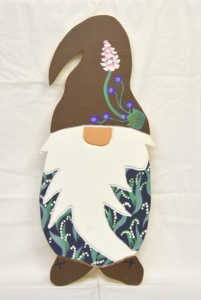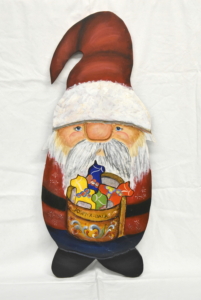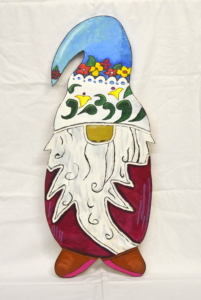2023 Exhibits
Gammelgården Museum has several exhibits each year.
For artists and those who enjoy viewing art, Gammelgården has exhibits that showcase contemporary and historical artwork.
View these exhibits online or in person!

Gammelgården Museum has several exhibits each year.
For artists and those who enjoy viewing art, Gammelgården has exhibits that showcase contemporary and historical artwork.
View these exhibits online or in person!
Art Exhibit in the Välkommen Hus
From May-October 2023, the main exhibit at Gammelgarden Museum of Scandia was Swedish Folk Painting – Tradition and Innovation. Below are images of the artists’ work as well as statements about their work in their own words.
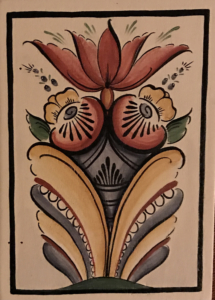
Originating in the 1700s in the county of Dalarna, Sweden, folk painting was a method to share Bible stories to an illiterate population.
These large wall hangings, painted on linen, helped make the Bible stories relevant to the Swedish population, but used 1700s Swedish dress and buildings (contextualizing). The paintings were displayed in churches and public buildings; and were very popular.
When painting the story of Jonah and the whale, the plant that grew up to shelter Jonah posed a challenge as the word for gourd translated to kurbits, and no one knew what a gourd was at that time.
However, knowing God caused the plant to grow overnight meant it must be spectacular and showed the power of God. So, the oversized plant with multiple flowers as well as huge leaves and seed pods represented that plant.
With time and popularity, the kurbits became the hallmark of Swedish folk painting and were added to every Bible story painting to remind people “Look what God can do,” although not textually accurate to the Bible.
With time, the kurbits became its own art form and decorated furniture, clocks, household items, and walls.
A similar art form developed independently in the southern parts of Sweden in the areas of Halland, Småland, and Skåne. These tapestry-like narratives were painted more like a movie being “read from left to right,” but still contextualized in current Swedish times. They were hung from the rafters with other woven textiles on special occasions such as Christmas and weddings.
By the 1750s, people started to memorialize significant events like weddings, coronations, military victories, or their own social position in this style (including the now-famous kurbits) to decorate their homes.
Several distinctive styles and color palettes developed: Lima, Leksand, Rattvik, and Halsingland.
Improved tools, paints, technology, and other art forms (like Renaissance) influenced Dala painting and still does, but also keeps the tradition alive and claimed.
With immigration, the art form as well as many of these panels, baskets, and personal items with Dalapainting and Kurbits came to America and became cherished here. It is a significant and distinctive part of Swedish folk art.
Painted in 1999, this basket, pictured below, was inspired by traditional Swedish basket painting called Korgmalning. Painted baskets in Sweden were often decorated with broken lines, repeated patterns, dots, circles, half-circles, and S-forms.
This clock was built by Mike Lusk and decorated by the artists with painting inspired by the Rattvik style of Swedish painting done on Mora Clocks from the Dalarna area of Sweden. Rattvik style was found on furniture and clocks. Mora Clocks are well recognized by their hour-glass shape. Decorated with wood graining and monochromatic painting. Colors regularly used were black, umbers with touches of red oxide, yellow oxide, blue green, blue grey. Stylized flowers and beautiful graphic borders are representative of this style of painting.
This tray was built by Mike Lusk and decorated by the artist with painting inspired by Swedish painting from the Dalarna area in Sweden. This style of painting has many names such as Kurbits, Dala Painting, and Dalamalning. The painting has Kurbits flower forms which originate from the Biblical story of Jonah where on dry land a plant (gourd) shaded him. Kurbits are recognizable with swell leaves and a variety of flowers. The painting generally tells a story where the stylized flowers surround a scene with people, animals, trees, and buildings, and is surrounded by borders, some of which include lettering. Colors typically used were toned red, blue, yellow, and green.
Exhibit numbers: 14, 23, 32
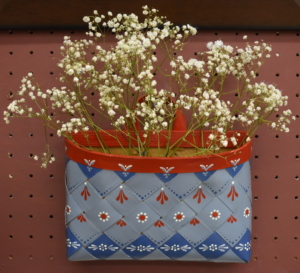
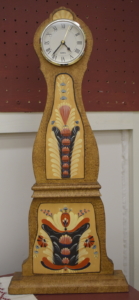
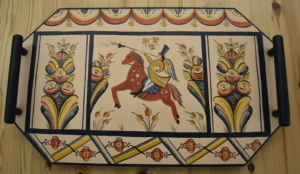
Big Kurbits – In May 2022, I found a printed kurbit textile in an antique shop in Falun, Sweden. It was printed in the 1950s by Jobs Handtryck, a fine textile printing company in Leksand. This print was inspired by an 18th century painting of a fantastical kurbit (curcubita) in a vase with a fancy umbrella and birds. Traditionally, the kurbit was believed to be a magical plant of protection and good luck. I reinterpreted it with a contemporary palette using acrylic paint on canvas.
Wise and Foolish – In this painting, I was inspired by southern Swedish artist Johannes Nilsson (1757-1827), the Sunnerboskolan, and other bonader painters. Nilsson filled his long narrative paintings with Biblical stories using 18th century Swedish motifs, fashions, folk patterns, and floating flowers and blue bubbles (blafargade bubblor). I include multiple figures placed in a formalized-iconic way surrounded by decorative motifs. I added bright colors and repeated patterns i nthe borders and dresses. This embellishment includes a drapery motif in the sky that I sourced from several traditional bonad paintings that suggests a theatrical moment.
Fest 2 – In this painting, I redrew, and reinterpreted a Wedding at Cana bonad, narrative painting, with a contemporary palette and my own stylized figures and forms. I paid close attention to the traditional bonadsmalningar that depicted Biblical scenes with people wearing Swedish fashions from the 1700s-1800s. In this painting, I present my work as a living cultural art form rooted in traditional Swedish folk paintings and changed to reflect my contemporary artistic sensibilities that celebrate the intersection of art, craft, and heritage.
Exhibit numbers: 1, 2, 3
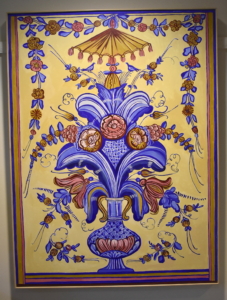

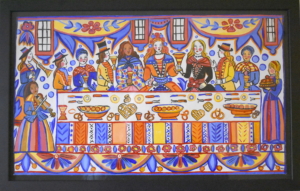
Whiskey cabinet with section for spoons, Drickamalning, Dalarna province inspired. Carpentry by Mike Lusk, Scandia Woodworks.
Octagon-shaped tray with faux finish called Drickamalning, Dalarna province inspired. Carpentry by Mike Lusk, Scandia Woodworks.
Framed canvas, Kurbits painting of Lake Pepin and early Swedish immigrants, Jon and Anna.
Key cabinet. Carpentry by Mike Lusk, Scandia Woodworks.
Exhibit numbers: 12, 22,25, 26
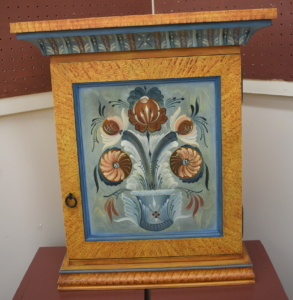
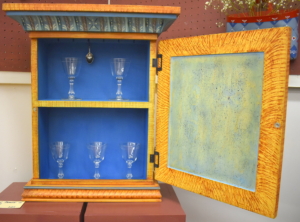
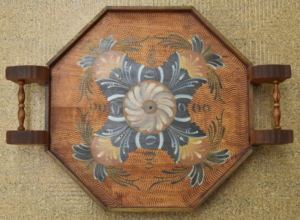
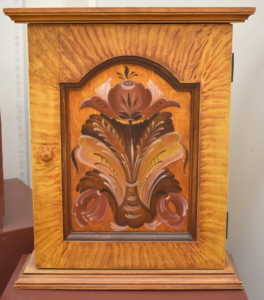
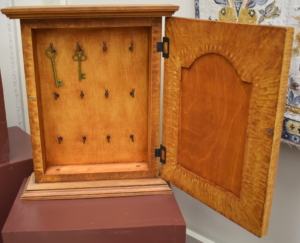
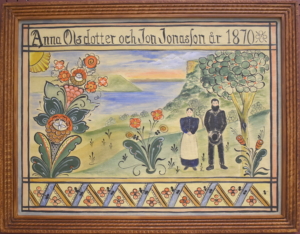
Kurbits in Vase – Limfarg, directly translated means “glue paint.” The artist colors are powdered pigment mixed with a warm glue made of animal hide or bone. This distemper paint is one of the traditional materials used by historical dal painters from the 18th and 19th centuries, as they traveled the region of central Sweden painting farm house interiors or doing commission work.
Begin Each Day – The phrase is homage to my mentor and dear friend, Karen Jenson, of Milan, Minnesota. She had painted this phrase on the inside the cover of a small box that sat on her dresser, and it reminds me of her outlook on life. Casein (a milk protein) mixed with powdered pigment forms the artist colors. The ground paint is homemade from an old recipe using flour, eggs, and chalk. These are some of the traditional materials used by the historical painters in Dalarna, along with linen, which was available due to the amount of flax grown in Sweden during the 18th and 19th centuries.
Silver Linings – The title Silver Linings, refers to the positive emotional outcomes of the quarantine during the Covid-19 pandemic during the spring of 2020. DUring this time, many people experienced a shifting in priorities as we were forced to face our own mortalities, reexamine how we spend our time and money, and isolate from our family, friends, work, and social environments.
This artwork shows the beautiful story of things that people were doing throughout our country, and specifically in the state of North Dakota, to make our isolation experience a little bit better for ourselves and each other.
Text: Pandemic Spring North Dakota. We join together while staying apart: making masks, cutting hearts, bringing poetry, music, and color to our elders. Tending things that grow, distributing essentials, and showing quiet love through a window. Grateful for a glimpse. Painted for the North Dakota Council on the Arts. Ar [year] 2020 by Pieper Fleck Bloomquist.
Top Panel: USDA Farmers to Families Food Box Program, supporting those impacted by the closure of hotels, restaurants, and other food source businesses by trucking food to a distribution center for local families.
Middle Panel: Bonadsmalning is modeled after medieval woven tapestries, and like those tapestries, the most important scenes were centered under an arch. The making of protective face masks, and the World of Hearts Facebook campaign are featured here, with essential workers flanking the center scene – in full PPE. On the far sides are musicians helping sustain local culture by assisting churches host services over radio transmitters.
Bottom Panel: The five sections narrate efforts to help our elders cope while isolated in healthcare and eldercare facilities. Across the state, musicians performed outdoor concerts in the courtyards, artists painted on windows and sidewalks, and writers spoke with elders through a window or on a cell phone to help put their memories into words. There was even a family in the Fargo/Moorhead area that rented a scissor lift to bring them up to the second-floor window for Grandma’s 90th birthday! All of these efforts were to help maintain relationships and human contact in a safe way.
“Mike Calls His Mom” found in the bottom panel towards the left, is my husband. During this time his mother required surgery and subsequent placement in a facility, where she eventually died while in isolation, THis scene is what I saw when she had been moved to the ground floor and we saw her for the first time. I remember looking at those other families, and at Mike, and all I could think was, “Look at all the love at these windows.”
This project is supported in part by a grant from the North Dakota Council on the Arts, which receives funding from the state legislature and the National Endowment for the Arts.
Exhibit numbers: 16, 19, 33
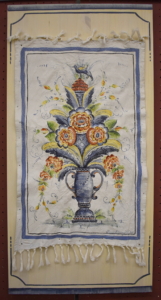
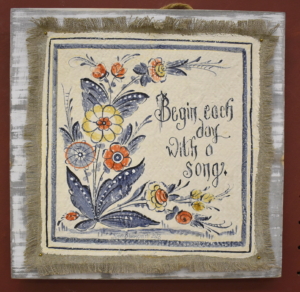
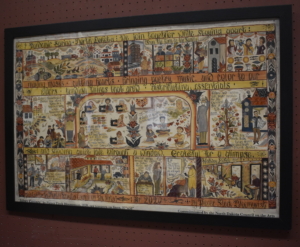
I am not a good painter, but I wanted to exhibit my painting to show that you can have fun painting without being a perfectionist. This was painted on a cupboard door that I salvaged from a dumpster. I like that it was recycled.
Exhibit number: 36
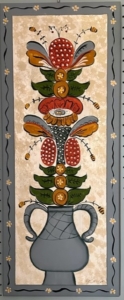
Outdoor background landscape with stylized Dala horse, kurbit, and building.
Beige background with still-life vase with kurbits, with artist’s trademark signature of a bird.
Black background with red framing, kurbits, and cardinal as a focus point.
Exhibit numbers: 4, 5,6
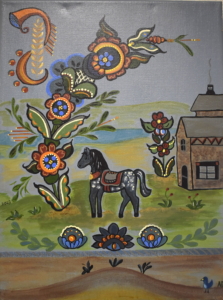
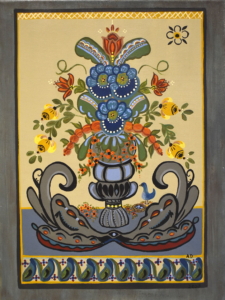
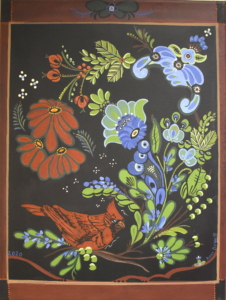
Alderstappen, The Steps of Life – One of the most iconic of all the Swedish folk art paintings this shows in ten-year increments the steps of the peasants’ lives. They are dressed in typical peasant clothing, and it starts with the cradles to the grave. Sometimes the illustrations are a little different with a baby and even a coffin at the end. Many of the Leksand painters in particular did their own version of the Alderstappen. This one was inspired by a painting by Winter Carl Hansson who was one of the best and most creative of all the Swedish painters. He died of pneumonia when he was only 30, which was a sad loss of such a gifted artist. This painting was done in 1799 and is in the Danielsgarden, Bingsjo which I visited in 2018.
Swedish Fishing Stool – This is a playful, fun painting for children or those who just enjoy the different motifs found in kurbits paintings. There are flowers and leaves and hearts and more flowers and, of course, the iconic Dala horse.
Tray with Handles – The kurbits on this tray was from a painting by Snarf Anders Andersson. The original painting was from the BIble parable of two blind men which was from the Picture Bible of 1739. The kurbits, or gourds, were added by the painter, which was a typical motif of his. I added the horseman and the church. My idea was of a celebration of a family event where he was on the way to church to celebrate the birth or wedding in his family. Woodenware made by Mike Lusk.
Exhibit numbers: 17, 24, 28
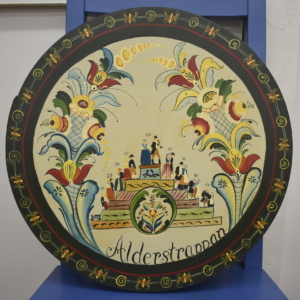
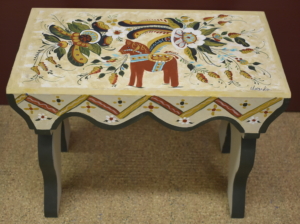
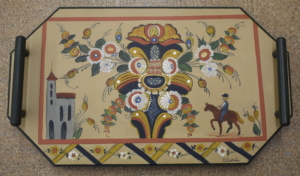
Plate – Players.
Plate – In Jesus’ name we go to the table.
Exhibit numbers: 9, 11
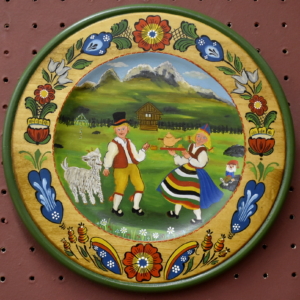
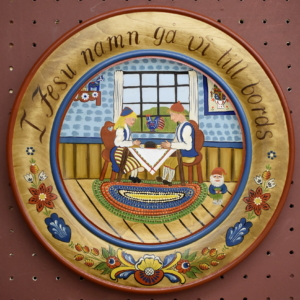
Always Stop and Smell the Bluebells – This painting is done in the traditional Dalmalning or Kurbitsmalning. It was painted on a wooden background which was turned by Tim Monztka. The medium used for painting is acrylic paint.
Done using traditional Dalmalning for inspiration, there are kurbits in a various shapes. The kurbits are the plants on either side of the design. Kurbits are typically found in the Swedish folk art of this region but not in the bonadsmålning of southern Sweden. My design then becomes the whimsical story of a Dala horse who has stopped to admire and smell the lovely bluebell flowers common in Sweden. Although not traditional to this style of painting, the Dala horse holds a special place in the hearts of many Swedes and those of us who are of Swedish descent.
Until We Meet Again In Heaven – This painting is done in the traditional style of the central Sweden called Dalmalning. It was painted on a wooden background which was made by woodworker Mike Lusk. The medium used of painting is acrylic paint. Done using traditional Dalmalning for inspiration, I painted this memory box in honor of my dad shortly after his death. His parents were from both the Leksand and Rattvik areas of Dalarna. I used influences from both styles of Dalmalning when designing this box to honor his heritage. The top has a cartouche done in the Rattvik style, using colors and kurbits common to that style. The front and sides are full of the kurbits common to the Leksand style. On the sides are a Dala horse with wings representing the collection of Dala horses he treasured from my grandmother. The back has my interpretation of the painting of Elijah riding up to Heaven in a chariot of fire. It is my dad heading to Heaven in his golf cart with my mom down below waving good-bye for now. The saying (painted in a very primitive style) says “Loving Husband, Father, and Grandfather: Watch over us until we meet again in Heaven.”
It’s Always Iggy! – This painting is done in the traditional style of southern Sweden called bonadsmålning. It was painted on linen which was prepared with gesso as a painting surface. The medium used for painting is colored powder pigments mixed with egg yolk to produce egg tempera paint. Done using traditional bonadsmålning design as inspiration, there is an upper border, a main picture consisting of the three cats looking out the window, clouds at the top, and curtains acting as borders on each side. There also is a border on the bottom. The cats were drawn with a stencil that were made for this design and done in the colorful style you see in the old bonadsmålning. The story being told here is of our kitten Iggy. In a modern take on bonadsmålning, Iggy is sitting on the windowsill with his brothers, but everything around him is broken including the flowerpot and his collar. In our house, if something is broken or knocked down, the saying goes…It’s Always Iggy!
Exhibit numbers: 10, 15, 21
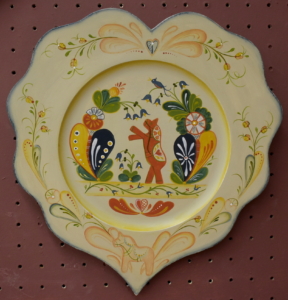
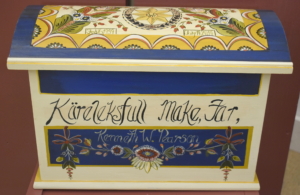
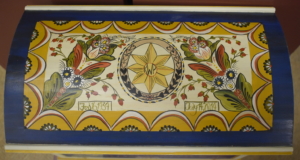
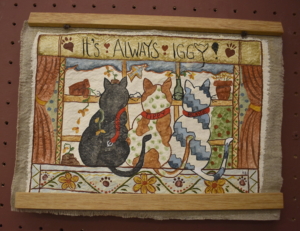
Angel of Glory – This piece of southern Swedish bonadsmålning is my first completed work in this art style. I am deeply fascinated by Angelology, and thus wanted to create my interpretation of the angels frequently found throughout the history of bonadsmålning.
Exhibit number: 20
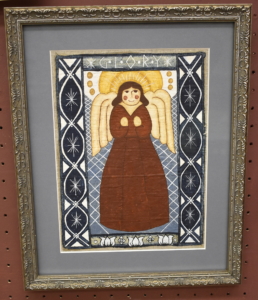
All three of my paintings are done in the centuries – old, traditional bonadsmålning style of southern Sweden, but with modern themes. They are painted on natural linen fabric gessoed with a mixture of rabbit-skin glue and chalk. The paint medium is egg tempera colored with powdered pigments.
Fox King – A king rides through the countryside on his horse.
Sweet Music – Based on a poem by Richard Watson Gilder, this painting celebrates music and friendship.
In Our Hands – Based on a quote from Sir Richard Attenborough, this painting features domestic farm animals and wild animals of North America in a message about climate change.
Exhibit numbers: 29, 30, 31
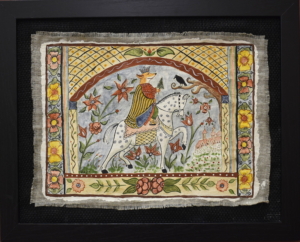
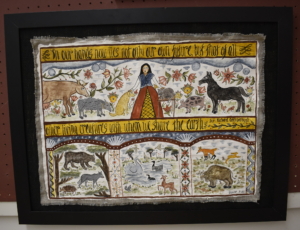
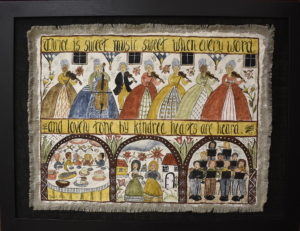
Exhibit number: 34
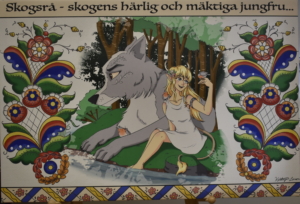
1 – Original 9″x12″ acrylic painting of Blue Dala Horse.
2. Digitized 8 1/2″x11″ version of original Blue Dala Horse painting.
3. Final printed note card and envelope of Dala Horse design.
This entry features an original Swedish folk art painting of a blue Dala Horse painted in acrylics. It shows how the original artwork was digitized and then used to create the final printed note card.
The design features the iconic Dala Horse, which is a symbol of good luck in Sweden. The Dala Horse originated in the Swedish province of Dalarna and many stories surround the history of it. Typically painted in the Kurbits style, Dala Horses feature bright colors and floral patterns that adorn wood, fabric, paper, and other pieces.
This Dala Horse note card is currently available for purchase in the Gammelgården Museum Butik.
Exhibit number: 35
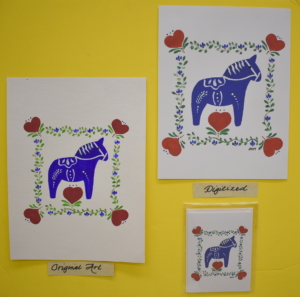
Gloria – I began this Bonads after my 2019 ASF Fellowship to Sweden where I studied Bonadsmalning at Unnaryd Bonadsmalning Museet. When designing the shepherds, I included one playing a recorder as a way to remember my co-Fellow who played her recorder each morning with the morning mist rising off the lake in front of our rental cabin while getting breakfast ready. I also included the Springer Spaniel one of our classmates brought with her each day to class as a nod to my very first pet as a child.
To Everything There Is A Season – The preparation of this linene was begun during my 2019 ASF Fellowship to Sweden while studying with Slotts Barbro. Upon returning home, I conceived the idea of a year of planting as seen through a farmhouse window. I was inspired by the harvest season and the many farmers markets as well as my husband’s family farm.
Exhibit numbers 7, 27
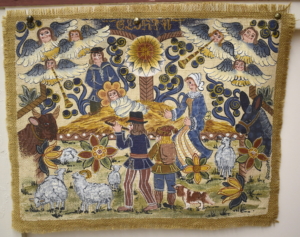
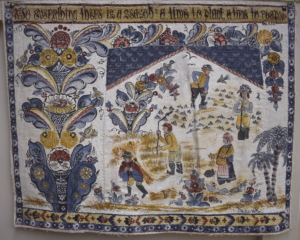
Mirror – Swedish Dalmalning is from the province of Dalarna located in central Sweden, spanning a period of almost 100 years dating from 1780-1870. Floral motifs known as kurbits sprout from the painting. The kurbits (or gourd plant) originated in the book of Jonah, in which the Lord caused a kurbit to grow and shade Jonah in the desert thus saving his life. Elements from these paintings were used on trunks, cabinets, plates, and other wooden items, like this mirror. The folded ribbon border was popular among the peasant painters. It was usually painted in two colors with a garland of flowers and leaves weaving over and under the ribbon. Design by Sandy Braun.
I Come From Dalarna 1919 – “I Come From Dalarna 1820” is the painting I worked on with Ase Larsjos while in Sweden on a Vesterheim Tour in 2018. Dal painting, a peasant art form practiced by self-taught, small-scale farmers in Dalarna, flourished from 1770 for a period of 100 years. Many painters came from Rattvik or Leksand. These painters traveled extensively around Sweden undertaking commissions depicting Biblical scenes, royalty, and everyday life. Their work supplemented their meager farm income. The scenes were light and colorful, and used to decorate the inside walls of Swedish homes. I changed the year to 1919 to commemorate the year my father and my grandparents emigrated from Mora, Sweden, to the United States.
Dalahasten – The Dalahasten (horses) were carved in small log cabins during the long winter ngihts. Itinerant peddlers sold the beautifully-carved and decorated horses when going to farming districts to sell their wares. Today, tourists visit Grannas in Nusnas to see how the genuine Dala horse is made. In Sweden today and in the world, the Dala horse is the best-known emblem of the province of Dalarna and a symbol of Sweden.
Exhibit numbers 8, 13, 18
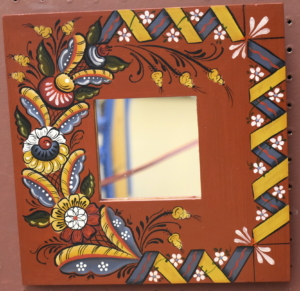
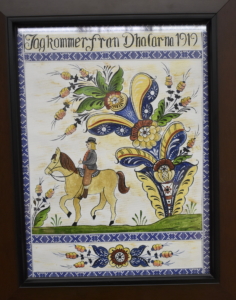
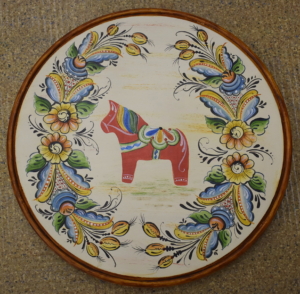
This painting is inspired by the Swedish folk painting of Dalarna. It is my expression of my love of my Scandinavian heritage. It is a depiction of my value of family history as a continuation of love through generations. I painted a Kurbit (as the protecting vine) in this work.
Exhibit number: 37
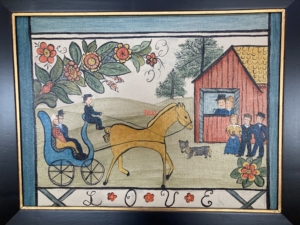
Tomte Community Art Show
Every two years, Gammelgården Museum holds a Community Art Show, inviting museum members and friends as well as local artists, professionals, and amateurs alike, to participate.
The 2023 Community Art Show featured 48 tomtes painted and decorated by 43 artists from around Scandia, the Twin Cities metro area, and Colorado. Our Tomte Community Art Show included artists of all backgrounds and experience levels as well as ages – from 7 years old to over 80 years old. Pieces included many media forms on the wood sculptures including painting, decoupage, stained glass, collage, and additional 3D embellishments.
This outdoor exhibit, which ran from August 28th – September 10th, 2023, was displayed on the tennis court fence at Barton Johnson Memorial Park (adjacent to Gammelgården Museum).
Allison Bachmann
Kelli Beaudry
Kelli Beaudry
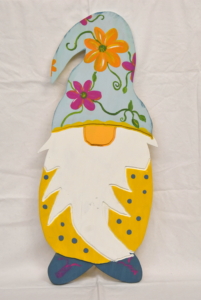
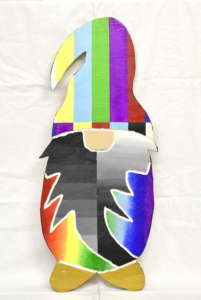
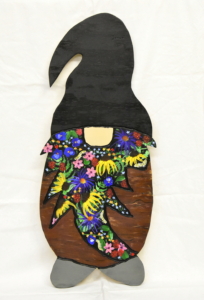
Becky Brunette
Ralph Carlson
Erica Crone
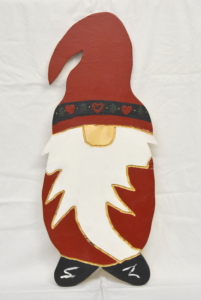
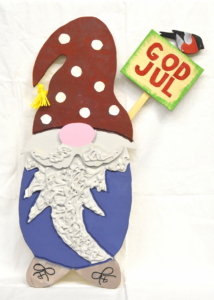
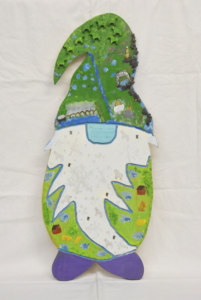
Sue Dickens
Paul Fluegel
Signe Fluegel
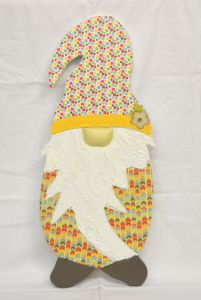
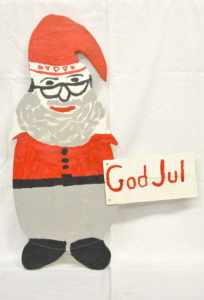
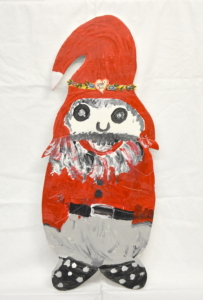
Eleanor Hargrove – Age 10
Darlene Holtgreve
Kristine Hubbard
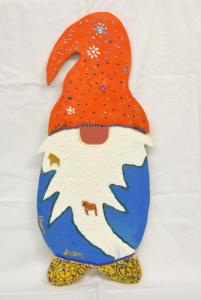
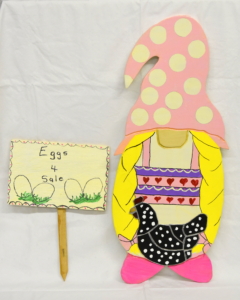
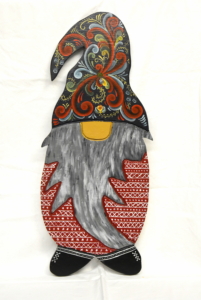
Kristine Hubbard
Kali Iverson – Age 8
Kira Iverson – Age 11
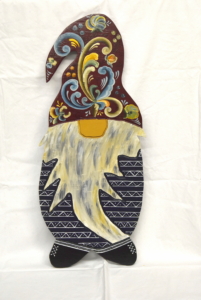
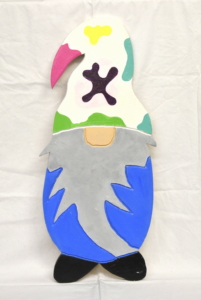
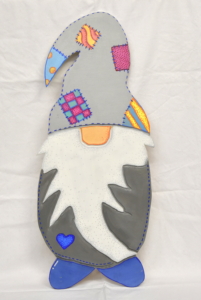
Deb Keech
Deb Keech
Patricia Mary Lange
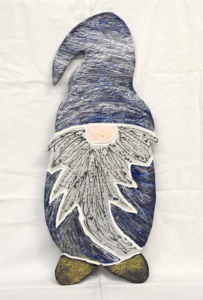
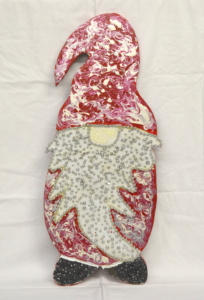
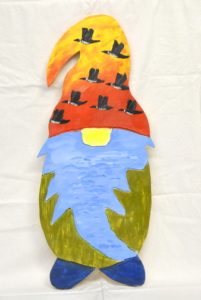
Karen Larson
Rachel Larson
Kris Lindberg
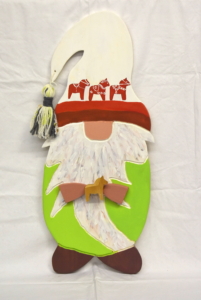
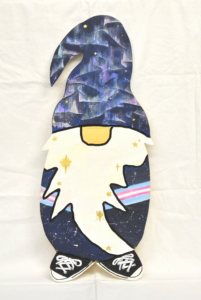
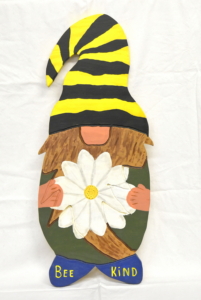
Jessica Lindemyer
Jessica Lindemyer
Jessica Lindemyer
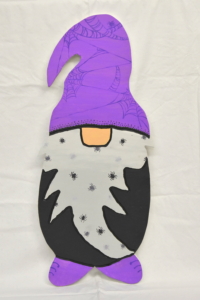
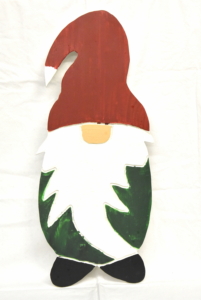
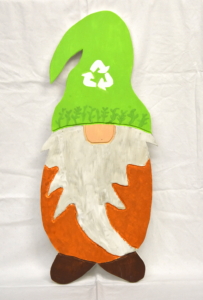
Christine Maefsky
Sarah Maefsky Johnson and Ava Johnson
Anne McLaffrety
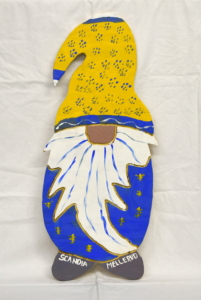
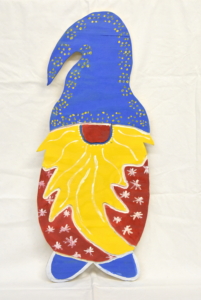
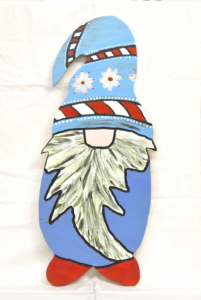
Ronan McLaffrety
David McQuay
Erin McQuay
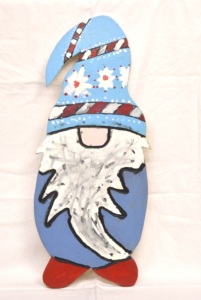
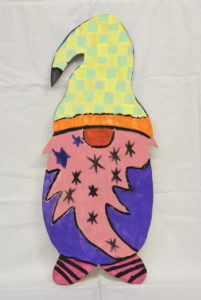
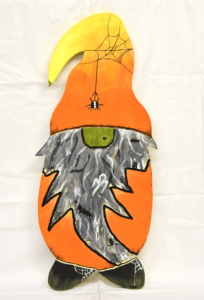
Mary Jo Milbrandt
Jay Moris
Leena Moris
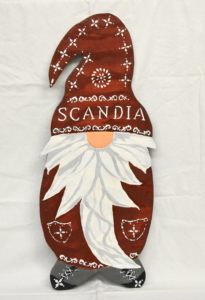
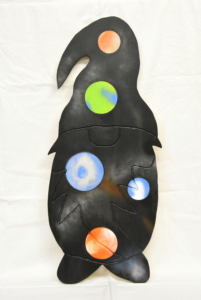
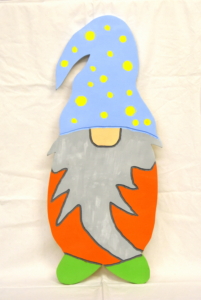
Kathy Moris
Bonnie Olsen –
Kendra Nielsen
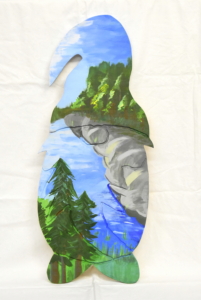

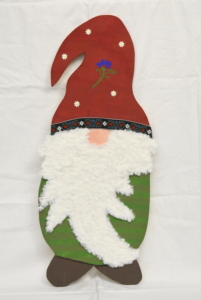
Rochelle Peace
Stephanie Pereboom
Debbie Richards
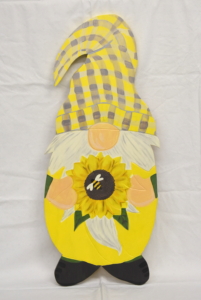
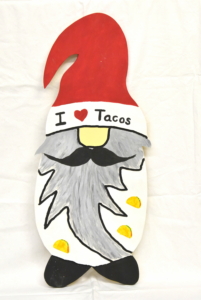
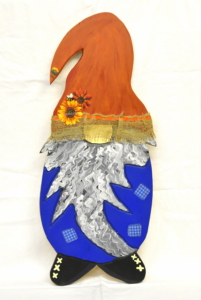
Chris Sedlund
Rebecca Skupien
Rebecca Skupien
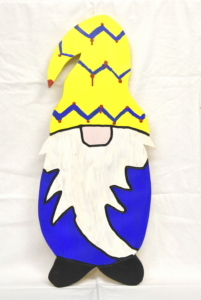
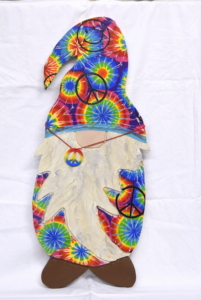
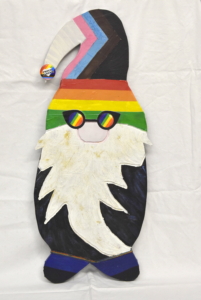
Becky Stegen
Cate Stegen
Emily Stegmeir
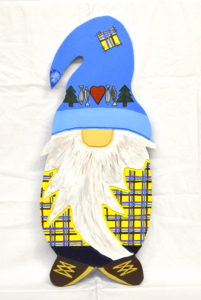
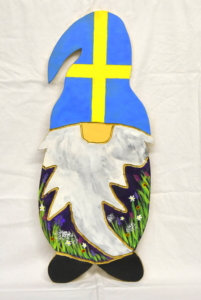
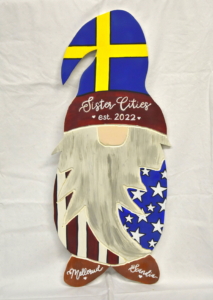
Erin Swanson
Ronna Thorson
Beth Toutges
